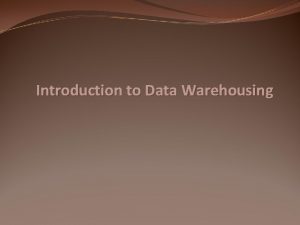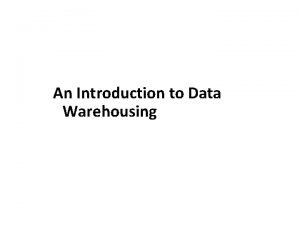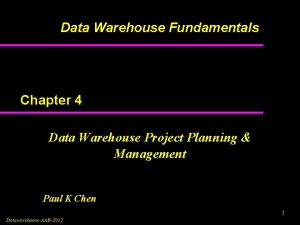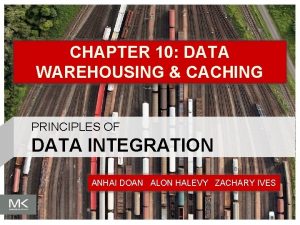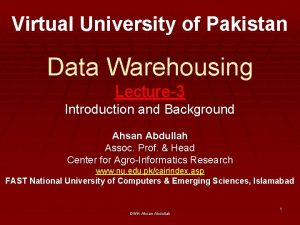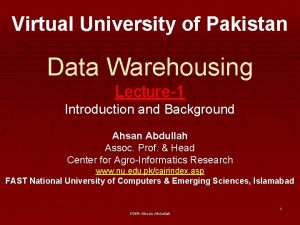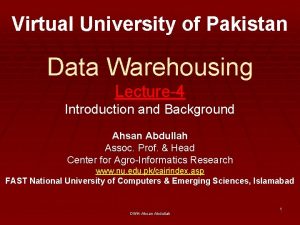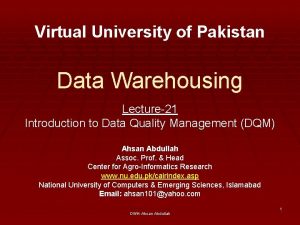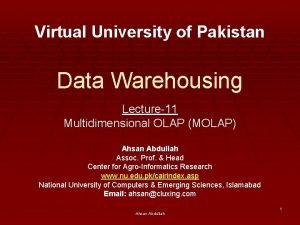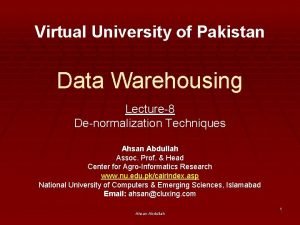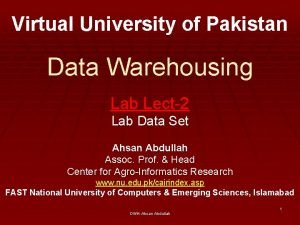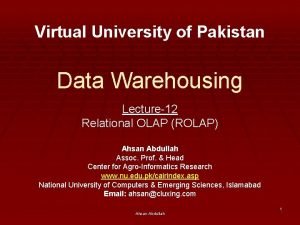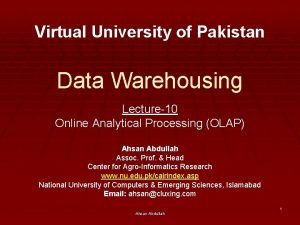Virtual University of Pakistan Data Warehousing Lecture3 Introduction












- Slides: 12

Virtual University of Pakistan Data Warehousing Lecture-3 Introduction and Background Ahsan Abdullah Assoc. Prof. & Head Center for Agro-Informatics Research www. nu. edu. pk/cairindex. asp FAST National University of Computers & Emerging Sciences, Islamabad DWH-Ahsan Abdullah 1

Introduction and Background 2 DWH-Ahsan Abdullah

What is a Data Warehouse ? It is a blend of many technologies, the basic concept being: Take all data from different operational systems. n If necessary, add relevant data from industry. n Transform all data and bring into a uniformat. n Integrate all data as a single entity. n 3 DWH-Ahsan Abdullah

What is a Data Warehouse ? (Cont…) It is a blend of many technologies, the basic concept being: Store data in a format supporting easy access for decision support. n Create performance enhancing indices. n Implement performance enhancement joins. n Run ad-hoc queries with low selectivity. n 4 DWH-Ahsan Abdullah

How is it Different? § Fundamentally different Business user needs info Answers result in more questions User requests IT people ? Business user may get answers IT people send reports to business user IT people do system analysis and design IT people create reports 5 DWH-Ahsan Abdullah

How is it Different? § Different patterns of hardware utilization 100% 0% Operational DWH Bus Service vs. Train 6 DWH-Ahsan Abdullah

How is it Different? § Combines operational and historical data. § Don’t do data entry into a DWH, OLTP or ERP are the source systems. § OLTP systems don’t keep history, cant get balance statement more than a year old. § DWH keep historical data, even of bygone customers. Why? § In the context of bank, want to know why the customer left? § What were the events that led to his/her leaving? Why? § Customer retention. 7 DWH-Ahsan Abdullah

How much history? § Depends on: § Industry. § Cost of storing historical data. § Economic value of historical data. 8 DWH-Ahsan Abdullah

How much history? § Industries and history § Telecomm calls are much more as compared to bank transactions- 18 months. § Retailers interested in analyzing yearly seasonal patterns- 65 weeks. § Insurance companies want to do actuary analysis, use the historical data in order to predict risk- 7 years. 9 DWH-Ahsan Abdullah

How much history? Economic value of data Vs. Storage cost Data Warehouse a complete repository of data? 10 DWH-Ahsan Abdullah

How is it Different? § Usually (but not always) periodic or batch updates rather than real-time. § The boundary is blurring for active data warehousing. § For an ATM, if update not in real-time, then lot of real trouble. § DWH is for strategic decision making based on historical data. Wont hurt if transactions of last one hour/day are absent. 11 DWH-Ahsan Abdullah

How is it Different? § Rate of update depends on: § volume of data, § nature of business, § cost of keeping historical data, § benefit of keeping historical data. 12 DWH-Ahsan Abdullah
 Introduction to data mining and data warehousing
Introduction to data mining and data warehousing Difference between operational and informational data
Difference between operational and informational data Introduction to data warehouse
Introduction to data warehouse Data mining in data warehouse
Data mining in data warehouse Javachive
Javachive Crm data warehouse models
Crm data warehouse models Olap in data mining
Olap in data mining Best practices for data warehousing
Best practices for data warehousing Coffing data warehousing
Coffing data warehousing Data warehouse component
Data warehouse component Data warehouse project plan
Data warehouse project plan Temporal parallelism
Temporal parallelism Data warehousing principles
Data warehousing principles

